英语肯定句变否定句所有规则21
英语肯定句改否定句口诀

英语肯定句改否定句口诀在英语语法中,人们经常需要将肯定句改为否定句,或者相反。
这是学习英语的一个重要部分,因为能够灵活运用肯定句和否定句的转换,可以使我们的表达更加丰富多样。
本文将为大家介绍一些英语肯定句改否定句的口诀,帮助我们更好地掌握这个技巧。
一、一般句式肯定改否定一般句式的肯定句改为否定句,只需要在动词前面加上"do not"或"does not"即可。
例如:He plays basketball every day.(他每天打篮球。
)→ He does not play basketball every day.(他不是每天打篮球。
)They eat lunch in the cafeteria.(他们在食堂吃午餐。
)→ They do not eat lunch in the cafeteria.(他们不是在食堂吃午餐。
)二、be动词肯定改否定be动词是英语中最常用的动词之一,其肯定形式为"is"、"am"、"are",改为否定形式只需在其后加上"not"即可。
例如:I am a teacher.(我是一名教师。
)→ I am not a teacher.(我不是一名教师。
)They are students.(他们是学生。
)→ They are not students.(他们不是学生。
)三、情态动词肯定改否定情态动词在英语中也占有重要地位,它们有自己的肯定形式和否定形式。
要将肯定形式转化为否定形式,只需在情态动词后面加上"not"即可。
例如:She can swim very well.(她会游泳得很好。
)→ She cannot swim very well.(她游泳不很好。
)You should listen to your parents.(你应该听父母的话。
英语肯定句改否定句的方法

肯定句改否定句的发:
1.看句子中有没有系动词或情态动词,如果有,就直接在系动词或情态动词后加not。
例如:They were busy yesterday.(他们昨天很忙),句子中有系动词were,改为否定句时就直接在系动词were 后加not,改为They were not busy yesterday.(他们昨天不忙)。
再例如You should stand here(你应该站在这儿),改为否定句,在情态动词should后加not,改为You should not stand here.(你不应该站在这儿)
2.句子中如果没有系动词或情态动词,就在实意动词前(主语后)don´t或doesn´t 或didn´t(根据实意动词的形态确定),实意动词必须变回原形。
例如:The children feel happy.(孩子们感到快乐),动词是原形形式的feel,所以在动词前加don´t,改为否定句:The children don´t feel happy.(孩子们感到不快乐)
再例如:She takes up the phone(她拿起电话),动词是单三形式的takes,所以在动词前加doesn´t,同时必须把句子中的takes变回原形take,改为否定句:She doesn´t take up the phone(她没拿起电话)
再例如:He told me a story(他给我讲了一个故事),动词是过去式形式的told,所以在动词前加didn´t,同时必须把句子中的told变回原形tell,改为否定句:He didn´t tell me a story(他没有给我故事)。
否定句及一般疑问句
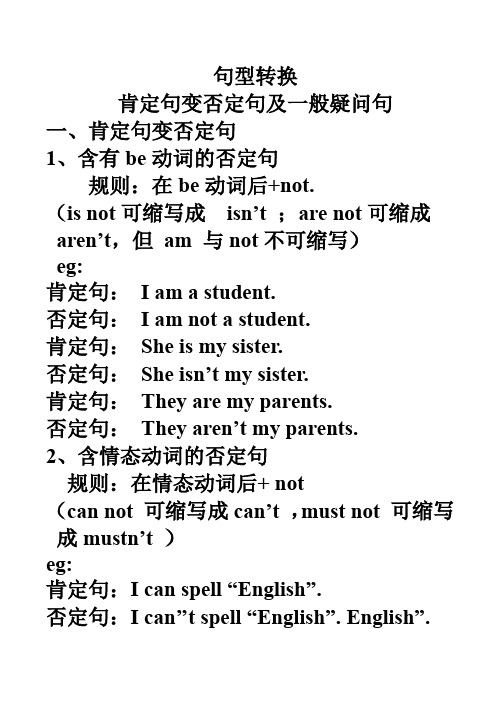
句型转换肯定句变否定句及一般疑问句一、肯定句变否定句1、含有be动词的否定句规则:在be动词后+not.(is not可缩写成isn’t ;are not可缩成aren’t,但am 与not不可缩写)eg:肯定句:I am a student.否定句:I am not a student.肯定句:She is my sister.否定句:She isn’t my sister.肯定句:They are my parents.否定句:They aren’t my parents.2、含情态动词的否定句规则:在情态动词后+ not(can not 可缩写成can’t ,must not 可缩写成mustn’t )eg:肯定句:I can spell “English”.否定句:I can’’t spell “English”.English”.肯定句:I must find it.否定句:I mustn’t find it.3、含有实义动词的句子的否定句构成(1)第三人称单数做主语。
(he、she、it或表示单个人或物的第三人称名词)规则:要在行为动词前加上助动词doesn’t,然后将动词恢复原形。
eg :肯定句:He has a soccer ball.否定句:He doesn’t have a soccer ball.(2)其它人称做主语规则:在行为动词前加don’t ,句子中的行为动词用原形。
eg:肯定句:They like bananas.否定句:They don’t like bananas.注:(1)在变否定句时,如遇some应变any Here are some books.Here aren’t any books.二、肯定句变一般疑问句1、含有be动词的句子变一般疑问句规则:把be动词提至句首,第一人称变第二人称,句末句号变问号。
(I/we变成youMy/our变成your)肯定句:I am a student.一般疑问句:Are you a student?肯定句:She is my sister.一般疑问句:Is she your sister?肯定句:They are my parents.一般疑问句:Are they your parents?2、含有情态动词的句子变一般疑问句规则:把情态动词提至句首,第一人称变第二人称,句末句号变问号。
初中英语肯定句变否定句
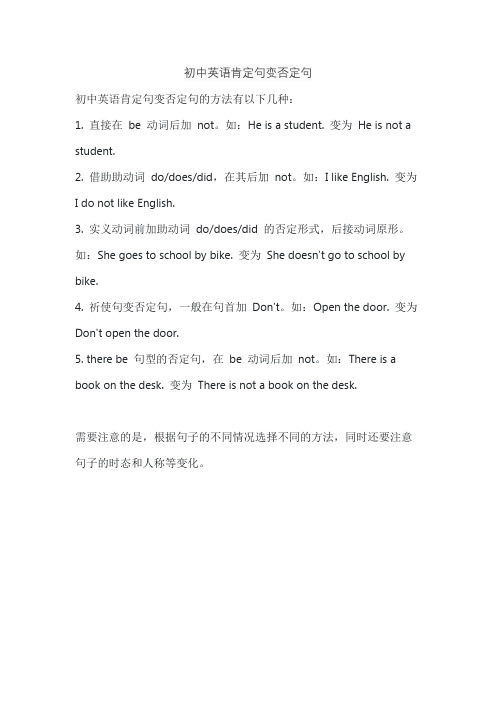
初中英语肯定句变否定句
初中英语肯定句变否定句的方法有以下几种:
1. 直接在be 动词后加not。
如:He is a student. 变为He is not a student.
2. 借助助动词do/does/did,在其后加not。
如:I like English. 变为
I do not like English.
3. 实义动词前加助动词do/does/did 的否定形式,后接动词原形。
如:She goes to school by bike. 变为She doesn't go to school by bike.
4. 祈使句变否定句,一般在句首加Don't。
如:Open the door. 变为Don't open the door.
5. there be 句型的否定句,在be 动词后加not。
如:There is a book on the desk. 变为There is not a book on the desk.
需要注意的是,根据句子的不同情况选择不同的方法,同时还要注意句子的时态和人称等变化。
英语肯定句变否定句所有规则21

一、简单句中含有b e动词、情态动词和助动词时,变否定句时需在be动词、情态动词和助动词后加not。
1. (am, is ,are 是be动词)如: I am a teacher.→Iamnota teacher.This is a pen.→ This is not a pen.或This isn’t a pen. (is not =isn’t) You are a boy. →You are not a boy. (are not =aren’t)2. (can是情态动词)He can help me.→Hecan not help me.或He can’t help me.(can not =can’t )3.当主语是第一人称、第二人称和第三人称复数时用助动词do,变否定时,在do后面加n ot 如:I like English .I do not like English.或I don’t like English.They go to school together. →They do not (don’t) go to schooltogether.4.当主语是第三人称单数时用d oes,变否定时,在does后面加not,如:The littlegirl wants to go there.→ The littlegirl does not (doesn't ) want to go there.2.简单句中谓语动词为行为动词时,要根据时态选用do的相应形式,把肯定句变为否定句。
如:The littlegirl wants to go there. →Thelittlegirl doesn't want to go there.He did his work yesterd ay.→ He didn't do his workyesterd ay.3.祈使句变否定句时,一般在句首加D on't,但Let us或Let's 开头的祈使句在Let us或Let's后加not也可。
英语肯定句变否定句的方法
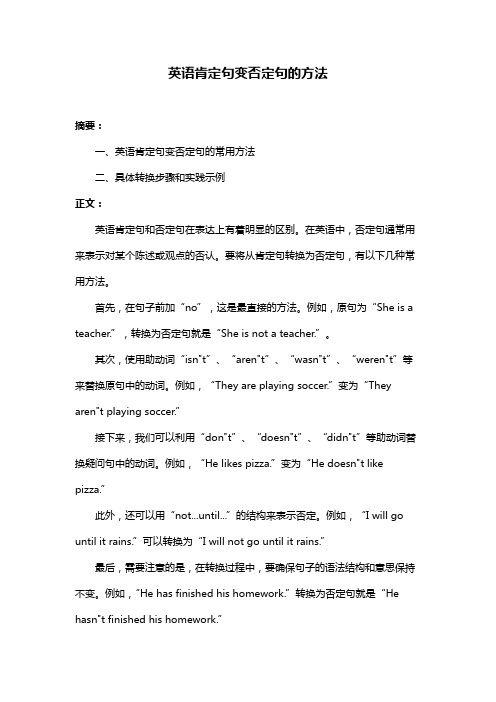
英语肯定句变否定句的方法摘要:一、英语肯定句变否定句的常用方法二、具体转换步骤和实践示例正文:英语肯定句和否定句在表达上有着明显的区别。
在英语中,否定句通常用来表示对某个陈述或观点的否认。
要将从肯定句转换为否定句,有以下几种常用方法。
首先,在句子前加“no”,这是最直接的方法。
例如,原句为“She is a teacher.”,转换为否定句就是“She is not a teacher.”。
其次,使用助动词“isn"t”、“aren"t”、“wasn"t”、“weren"t”等来替换原句中的动词。
例如,“They are playing soccer.”变为“They aren"t playing soccer.”接下来,我们可以利用“don"t”、“doesn"t”、“didn"t”等助动词替换疑问句中的动词。
例如,“He likes pizza.”变为“He doesn"t like pizza.”此外,还可以用“not...until...”的结构来表示否定。
例如,“I will go until it rains.”可以转换为“I will not go until it rains.”最后,需要注意的是,在转换过程中,要确保句子的语法结构和意思保持不变。
例如,“He has finished his homework.”转换为否定句就是“He hasn"t finished his homework.”总之,掌握以上方法,就可以轻松地将英语肯定句转换为否定句。
在实际应用中,根据不同的语境和句子结构,选择合适的方法进行转换,使句子更加丰富和生动。
(完整版)英语语法之肯定句变否定句

英语语法之肯定句变否定句一、肯定句变否定句口诀给句子分析它,看它结构是哪个主加be后加not 其他一切全照抄主加动词主重要don't doesn’t 来帮忙don’t doesn't 中间夹doesn’t doesn't 最特殊第三人称单数全靠它二、简单句的句子结构1.主语+be+其他2.主语+动词+其他备注:其中be里包括(am is are)判断下列各句是主语加be还是主语加动词1.I am a girl.2.I like singing。
3.We go to school every day.4.They are good friends.5.He works hard.6.She likes playing with toys.7.My mother watches TV every day.8.You are a beautiful girl.9.Tom is playing football on the playground。
10.Bill does his homework after supper。
三、肯定句变否定句规则肯定句主语+be+其他变成主语+be+not+其他主语+动词+其他变成主语+don't+动词+其他主语(第三人称单数)+动词单三+其他变成主语(第三人称单数)+doesn’t +动词原形+其他练习1.She is watching TV now。
2.We go to school on Sunday.3.His father works hard.4.Jack's mother is a nurse.5.The cat runs fast。
6.They like reading books.7.My grandpa gives me a hot dog。
8.Tom often walks to school。
9.I have a doll.10.It is eating fish.。
六年级英语肯定句改否定句

一、肯定句改否定句的方法:1、在be动词后加not。
如:is not , are not ,am not, was not, were not;2、在can,should, will等后加not。
如:cannot,should not, will not;3、上述都没有的,在动词前加助动词否定形式don’t/doesn’t/didn’t。
4、 some 改成any。
如: I am a girl. → I am not a girl.You are a student. →You are not a student.→You aren’t a student.This is Tom’s bag, → This is not Tom’s bag.→ This isn’t Tom’s bag.答题方法是;否定词not在be后边。
二、肯定句改一般疑问句的方法:1、把be动词放在句首,剩下的照抄,(some 改成any,I改成you,my改成your,)句点改成问号。
2、把can,shall, will等放到句首,剩下的照抄,(some 改成any,I改成you,my改成your,)句点改成问号。
3、上述都没有的,在句首请助动词Do/Does/Did帮忙,剩下的照抄,(some 改成any,I改成you,my 改成your,)句点改成问号。
注意:句首的第一个字母要大写,句尾标点应为“?”。
如:I am in Class 6. →Are you in Class 6?You are from America. →Are you from America? It is an orange. →Is it an orange?答题方法是:要想提问,be提前,句末“?”别忘了。
4、就一般疑问句回答一般疑问句有两种回答,即:肯定回答和否定回答。
其中,肯定回答用yes,否定回答用no。
语句顺序为:Yes + 主语+ am /is/ are/was/were.|can.|do/does/did|; No + 主语+ am not/ isn’t/ aren’t/wasn't/weren't.|can't.|don't/doesn't/didn't |.。
肯定句变否定句英语
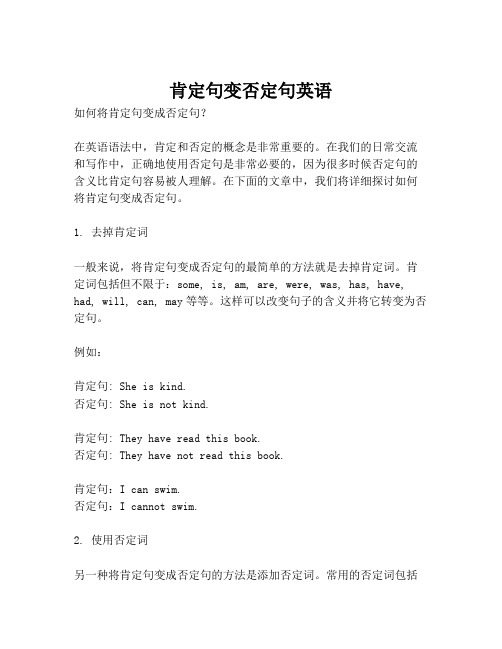
肯定句变否定句英语如何将肯定句变成否定句?在英语语法中,肯定和否定的概念是非常重要的。
在我们的日常交流和写作中,正确地使用否定句是非常必要的,因为很多时候否定句的含义比肯定句容易被人理解。
在下面的文章中,我们将详细探讨如何将肯定句变成否定句。
1. 去掉肯定词一般来说,将肯定句变成否定句的最简单的方法就是去掉肯定词。
肯定词包括但不限于:some, is, am, are, were, was, has, have, had, will, can, may等等。
这样可以改变句子的含义并将它转变为否定句。
例如:肯定句: She is kind.否定句: She is not kind.肯定句: They have read this book.否定句: They have not read this book.肯定句:I can swim.否定句:I cannot swim.2. 使用否定词另一种将肯定句变成否定句的方法是添加否定词。
常用的否定词包括但不限于:no, not, never, nothing, neither等等。
使用这些否定词能给句子带来否定的意义。
例如:肯定句: He asked me something.否定句: He didn’t ask me anything.肯定句: He always comes late.否定句: He never comes early.肯定句: I like coffee.否定句: I don’t like coffee.3. 使用相反的形容词或副词在有些情况下,我们可以使用相反的形容词或副词来将肯定句变成否定句。
例如,将“happy”换成“unhappy”,将“fast”换成“slow”等等。
例如:肯定句:She is beautiful.否定句:She is not ugly.肯定句:He is tall.否定句:He is not short.肯定句:He runs fast.否定句:He does not run slowly.总之,在英语语法中,正确使用肯定句和否定句非常重要。
肯定句变否定句的规则

肯定句变否定句的规则在英语语法中,将肯定句变成否定句的规则是非常重要的。
在实际的英语交流中,有许多时候需要使用否定句来表达自己的意图,因此掌握这个规则是至关重要的。
在英语中,将肯定句变成否定句有几种方法。
以下是几种最常用的方法:1.将be动词或动词的辅助动词not加在肯定句中。
例如:肯定句:She is happy.否定句:She is not happy.2.使用否定词,如never,not,hardly,scarcely,little 等。
例如:肯定句:I always drink coffee in the morning.否定句:I never drink coffee in the morning.3.使用两个否定词表达肯定的含义。
例如:肯定句:I have nothing to do.否定句:I don't have nothing to do.(=I have something to do.)需要注意的是,否定句中的句子结构常常会发生变化。
例如:肯定句:He speaks English well.否定句:He does not speak English well.在这个例子中,主语和动词之间插入了动词的辅助动词does。
这是因为在一般现在时和一般过去时中,要使用动词的辅助动词来表示否定意义。
此外,某些词语的否定形式也要格外留意。
例如:肯定句:I have some money.否定句:I have no money.肯定句:There is a book on the desk.否定句:There is no book on the desk.总之,在学习英语语法时,将肯定句变成否定句的规则是必不可少的一部分。
只有熟练地掌握了这些规则,才能在实际的英语交流中更自如地表达自己的意图。
英语肯定句改否定句口诀
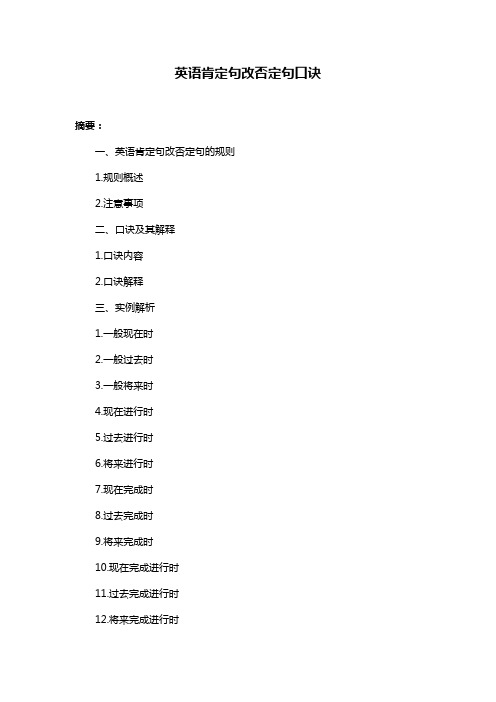
英语肯定句改否定句口诀摘要:一、英语肯定句改否定句的规则1.规则概述2.注意事项二、口诀及其解释1.口诀内容2.口诀解释三、实例解析1.一般现在时2.一般过去时3.一般将来时4.现在进行时5.过去进行时6.将来进行时7.现在完成时8.过去完成时9.将来完成时10.现在完成进行时11.过去完成进行时12.将来完成进行时正文:英语肯定句改否定句是英语语法中的一个重要环节,掌握好这个规则对于英语学习者来说非常关键。
下面,我们通过一个口诀来帮助大家更好地理解和运用这个规则。
一、英语肯定句改否定句的规则1.规则概述在英语中,将肯定句改为否定句主要遵循以下三种规则:(1)在动词前加not(2)借助助动词do, does, did(3)借助助动词have, has, had2.注意事项(1)注意保持时态的一致性(2)注意主语的一致性二、口诀及其解释1.口诀内容“没有(no)要助(do)动,有(yes)要主(have)动。
”2.口诀解释这个口诀简洁明了地概括了英语肯定句改否定句的规则。
当我们需要将一个肯定句改为否定句时,可以根据情况选择使用“没有要助动”或“有要主动”的方法。
三、实例解析以下是一些英语时态的实例,展示了如何将肯定句改为否定句:1.一般现在时肯定句:I study English every day.否定句:I do not study English every day.2.一般过去时肯定句:I studied English yesterday.否定句:I did not study English yesterday.3.一般将来时肯定句:I will study English tomorrow.否定句:I will not study English tomorrow.4.现在进行时肯定句:I am studying English now.否定句:I am not studying English now. 5.过去进行时肯定句:I was studying English then.否定句:I was not studying English then.6.将来进行时肯定句:I will be studying English then.否定句:I will not be studying English then.7.现在完成时肯定句:I have studied English.否定句:I have not studied English.8.过去完成时肯定句:I had studied English.否定句:I had not studied English.9.将来完成时肯定句:I will have studied English.否定句:I will not have studied English.10.现在完成进行时肯定句:I have been studying English.否定句:I have not been studying English.11.过去完成进行时肯定句:I had been studying English.否定句:I had not been studying English.12.将来完成进行时肯定句:I will have been studying English.否定句:I will not have been studying English.通过以上实例和口诀,相信大家对英语肯定句改否定句的规则已经有了更深入的了解。
英语肯定句改为否定句的方法
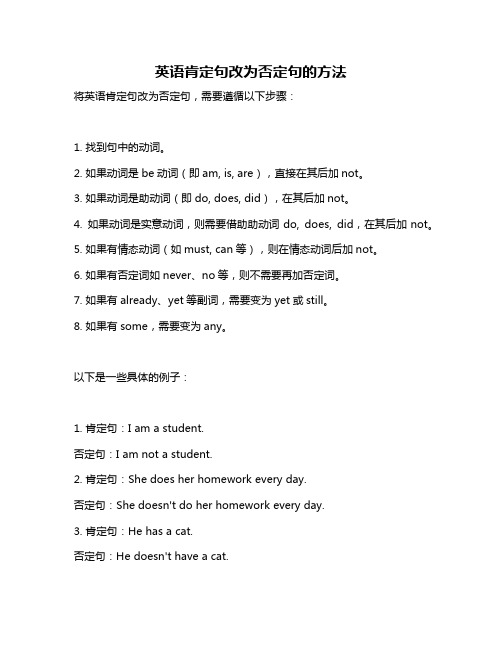
英语肯定句改为否定句的方法
将英语肯定句改为否定句,需要遵循以下步骤:
1. 找到句中的动词。
2. 如果动词是be动词(即am, is, are),直接在其后加not。
3. 如果动词是助动词(即do, does, did),在其后加not。
4. 如果动词是实意动词,则需要借助助动词do, does, did,在其后加not。
5. 如果有情态动词(如must, can等),则在情态动词后加not。
6. 如果有否定词如never、no等,则不需要再加否定词。
7. 如果有already、yet等副词,需要变为yet或still。
8. 如果有some,需要变为any。
以下是一些具体的例子:
1. 肯定句:I am a student.
否定句:I am not a student.
2. 肯定句:She does her homework every day.
否定句:She doesn't do her homework every day.
3. 肯定句:He has a cat.
否定句:He doesn't have a cat.
4. 肯定句:They will come here.
否定句:They won't come here.
5. 肯定句:We must finish our work today. 否定句:We must not finish our work today.。
英语肯定句改为否定句口诀

英语肯定句改为否定句口诀
以下是一些常见的英语肯定句改为否定句的口诀,帮助您快速掌握。
1.一般现在时
-肯定句:主语+动词原形
-否定句:主语+do/does not+动词原形
2.一般过去时
-肯定句:主语+动词过去式
-否定句:主语+did not+动词原形
3.一般将来时
-肯定句:主语+will+动词原形
-否定句:主语+will not/won't+动词原形
4.现在进行时
-肯定句:主语+am/is/are+动词-ing形式
-否定句:主语+am/is/are not+动词-ing形式
5.现在完成时
-肯定句:主语+have/has+过去分词
-否定句:主语+have/has not+过去分词
6.过去进行时
-肯定句:主语+was/were+动词-ing形式
-否定句:主语+was/were not+动词-ing形式
7.过去完成时
-肯定句:主语+had+过去分词
-否定句:主语+had not+过去分词
8.情态动词
-肯定句:主语+情态动词+动词原形
-否定句:主语+情态动词+not+动词原形
9.be动词(一般现在时)
-肯定句:主语+am/is/are
-否定句:主语+am/is/are not
10.be动词(一般过去时)
-肯定句:主语+was/were
-否定句:主语+was/were not
这些口诀可以帮助您快速记住肯定句改为否定句的基本规则。
然而,需要注意的是,有些特殊情况下,否定形式可能会有其他变化或使用不同的词汇。
因此,在具体应用时,仍需结合具体语境和语法规则进行判断和运用。
英语 肯定句变为否定规则
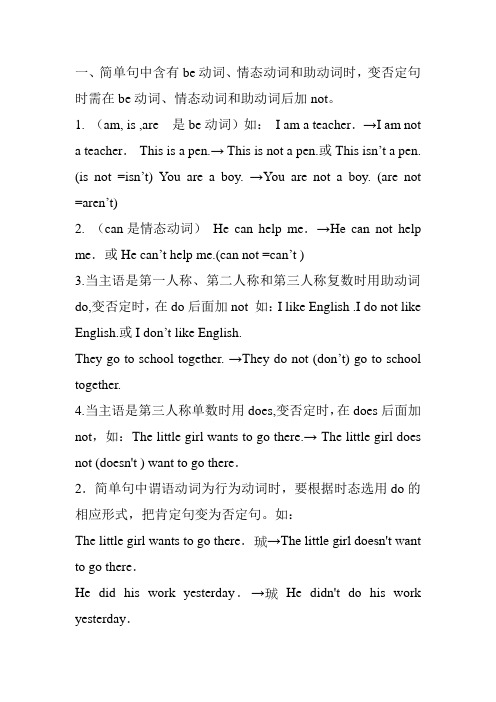
一、简单句中含有be动词、情态动词和助动词时,变否定句时需在be动词、情态动词和助动词后加not。
1. (am, is ,are 是be动词)如:I am a teacher.→I am nota teacher.This is a pen.→ This is not a pen.或This isn’t a pen. (is not =isn’t) You are a boy. →You are not a boy. (are not =aren’t)2. (can是情态动词)He can help me.→He can not help me.或He can’t help me.(can not =can’t )3.当主语是第一人称、第二人称和第三人称复数时用助动词do,变否定时,在do后面加not 如:I like English .I do not like English.或I don’t like English.They go to school together. →They do not (don’t) go to school together.4.当主语是第三人称单数时用does,变否定时,在does后面加not,如:The little girl wants to go there.→ The little girl does not (doesn't ) want to go there.2.简单句中谓语动词为行为动词时,要根据时态选用do的相应形式,把肯定句变为否定句。
如:The little girl wants to go there.→The little girl doesn't want to go there.He did his work yesterday.→He didn't do his work yesterday.3.祈使句变否定句时,一般在句首加Don't,但Let us或Let's 开头的祈使句在Let us或Let's后加not也可。
肯定句变为否定句的一些情况
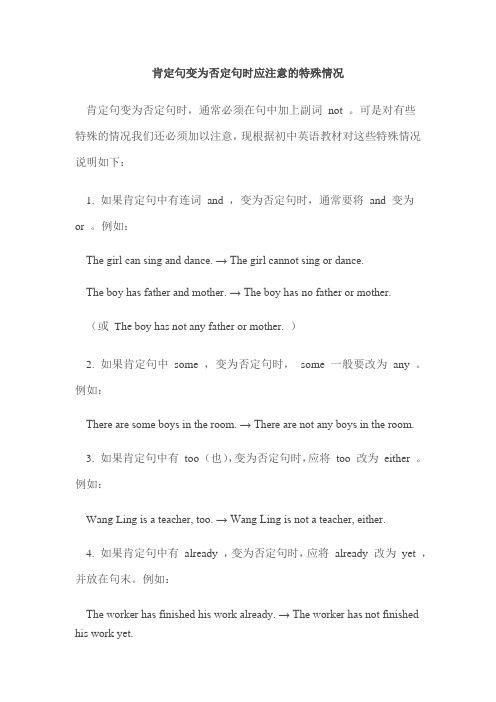
肯定句变为否定句时应注意的特殊情况肯定句变为否定句时,通常必须在句中加上副词not 。
可是对有些特殊的情况我们还必须加以注意,现根据初中英语教材对这些特殊情况说明如下:1. 如果肯定句中有连词and ,变为否定句时,通常要将and 变为or 。
例如:The girl can sing and dance. → The girl cannot sing or dance.The boy has father and mother. → The boy has no father or mother.(或The boy has not any father or mother. )2. 如果肯定句中some ,变为否定句时,some 一般要改为any 。
例如:There are some boys in the room. → There are not any boys in the room.3. 如果肯定句中有too (也),变为否定句时,应将too 改为either 。
例如:Wang Ling is a teacher, too. → Wang Ling is not a teacher, either.4. 如果肯定句中有already ,变为否定句时,应将already 改为yet ,并放在句末。
例如:The worker has finished his work already. → The worker has not finished his work yet.5. 如果肯定句中有“ had better ”,变为否定句时,not 要放在“ ha d better ”之后。
例如:You had better write to your teacher. → You had better not write to your teacher.6. 如果肯定句中有always ,变为否定句时,要将always 改为never 。
英语肯定句改否定句口诀
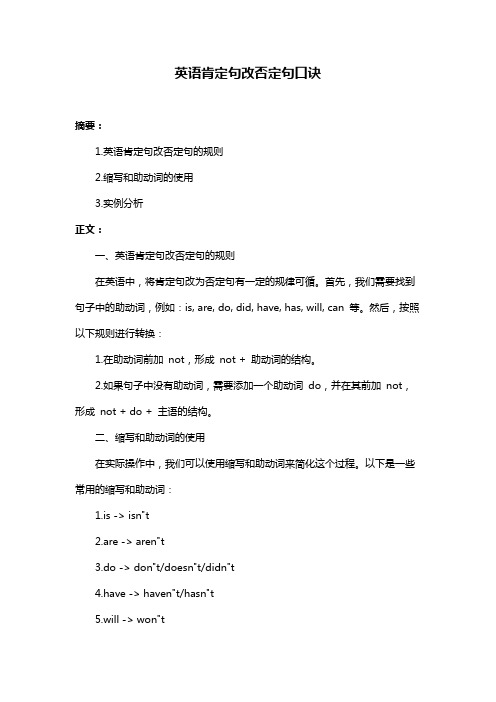
英语肯定句改否定句口诀摘要:1.英语肯定句改否定句的规则2.缩写和助动词的使用3.实例分析正文:一、英语肯定句改否定句的规则在英语中,将肯定句改为否定句有一定的规律可循。
首先,我们需要找到句子中的助动词,例如:is, are, do, did, have, has, will, can 等。
然后,按照以下规则进行转换:1.在助动词前加not,形成not + 助动词的结构。
2.如果句子中没有助动词,需要添加一个助动词do,并在其前加not,形成not + do + 主语的结构。
二、缩写和助动词的使用在实际操作中,我们可以使用缩写和助动词来简化这个过程。
以下是一些常用的缩写和助动词:1.is -> isn"t2.are -> aren"t3.do -> don"t/doesn"t/didn"t4.have -> haven"t/hasn"t5.will -> won"t6.can -> can"t三、实例分析下面我们通过一些实例来具体分析如何使用这些规则:1.肯定句:I am a student.否定句:I am not a student.(直接在am 前加not)2.肯定句:She has a book.否定句:She has not a book.(添加助动词do,并在其前加not)3.肯定句:He will go to the park.否定句:He will not go to the park.(直接在will 前加not)4.肯定句:They can swim.否定句:They cannot swim.(添加助动词can,并在其前加not)通过以上实例,我们可以看出英语肯定句改否定句的方法和规律。
英语肯定句改否定句口诀

英语肯定句改否定句口诀
摘要:
1.英语肯定句的基本结构
2.如何将肯定句改为否定句
3.英语否定句的构成
4.口诀记忆法
正文:
一、英语肯定句的基本结构
英语肯定句的基本结构是:“主语+ 谓语+ 宾语”,例如:“I love you”。
在这个结构中,主语是执行动作的人或事物,谓语表示动作,宾语则表示动作的承受者。
二、如何将肯定句改为否定句
要将肯定句改为否定句,需要在谓语动词前加上助动词“do”的相应形式,同时将动词变为原形的否定形式。
例如,将“I love you”改为否定句,可以这样操作:“Do I love you?”→“I don"t love you”。
三、英语否定句的构成
英语否定句的基本结构是:“主语+ 助动词(do 的适当形式)+ 动词(原形的否定形式)+ 宾语”,例如:“I don"t love you”。
四、口诀记忆法
为了方便记忆,我们可以用一个口诀来帮助记忆:“肯定句变否定,助动词来帮忙,前加do 后变no,否定句便完成”。
这个口诀的意思是:要将肯定句
改为否定句,先在谓语动词前加上助动词“do”,然后将动词变为原形的否定形式(即在动词前加“no”)。
这样,一个否定句就完成了。
通过以上讲解,相信大家已经了解了如何将英语肯定句改为否定句。
- 1、下载文档前请自行甄别文档内容的完整性,平台不提供额外的编辑、内容补充、找答案等附加服务。
- 2、"仅部分预览"的文档,不可在线预览部分如存在完整性等问题,可反馈申请退款(可完整预览的文档不适用该条件!)。
- 3、如文档侵犯您的权益,请联系客服反馈,我们会尽快为您处理(人工客服工作时间:9:00-18:30)。
一、简单句中含有be动词、情态动词和助动词时,变否定句时需在be动词、情态动词和助动词后加not。
1. (am, is ,are 是be动词)如:I am a teacher.→I am nota teacher.This is a pen.→ This is not a pen.或This isn’t a pen. (is not =isn’t) You are a boy. →You are not a boy. (are not =aren’t)2. (can是情态动词)He can help me.→He can not help me.或He can’t help me.(can not =can’t )3.当主语是第一人称、第二人称和第三人称复数时用助动词do,变否定时,在do后面加not 如:I like English .I do not like English.或I don’t like English.They go to school together. →They do not (don’t) go to school together.4.当主语是第三人称单数时用does,变否定时,在does后面加not,如:The little girl wants to go there.→ The little girl does not (doesn't ) want to go there.2.简单句中谓语动词为行为动词时,要根据时态选用do的相应形式,把肯定句变为否定句。
如:The little girl wants to go there.→The little girl doesn't want to go there.He did his work yesterday.→He didn't do his workyesterday.3.祈使句变否定句时,一般在句首加Don't,但Let us或Let's 开头的祈使句在Let us或Let's后加not也可。
如:Put them over there.→Don't put them over there.Let us go home.→Let us not go home.或Don’t let us go home.4.主从复合句中,主句是I think,I believe等结构,变否定句时,形式上否定主句,实际上否定从句。
如:I don't think chickens can swim .我认为鸡不会游泳。
5.“had better+动词原形”,变否定句时为“had better not +动词原形”。
如:You'd better go to school.→ You'd better not go to school.6.动词不定式变否定式时,常在不定式to前加not。
如:The teacher tells me to do it.→ The teacher tells me not to do it.7.使役动词和感官动词(make,let,hear,see,watch等)后接省略to的不定式,此种不定式变否定句时只需在省略to 的动词原形前加not。
如:I saw her work.→I saw her not work.8.特殊形式的否定句,有以下几种:(1)肯定句含有every-的合成词时,变否定句时改为no-。
如:Everything is ready.→Nothing is ready.(2)肯定句中含有always,usually和ever时,变否定句时改为never。
如:He is always late for school.→He is never late for school.(3)肯定句含有many,much时,变否定句时分别改为few,little。
如:Many students know him.→Few students know him.(4)肯定句中含有still时,变否定句时应改为no longer。
如:Tom is still in bed.→Tom is no longer in bed.(5)肯定句含有both,both...and,all时,变否定句时应改为never,neither...nor,none。
如:Both of us are students.→Neither of us is a student.(6)肯定句含有nearly,almost时,变否定句时应改为hardly。
如:Lily nearly knows him .→Lily hardly knows him .(7)肯定句含有“形容词+enough”时,变为否定句时应改为“too +形容词的反义词”。
如:He is short enough to reachit.He is too tall to reach it.(1)谓语动词是be,have(有)或谓语含有助动词、情态动词时,直接在这些词后加上否定词not。
如:She can swim.She can't swim.(2)谓语动词是行为动词时,要在该动词前加上do /does/did not,该词恢复原形。
如:He gets up early.He doesn't get up early.(3)既要否定谓语动词,又要变换句中的单词。
如:He can read and write.He can't read or write.(4)用含否定意义的词或词组取代肯定句中的某些词或词组。
如:I know both English and Chi- nese.I know neither English nor Chinese.类似的有:ever /always never,somebody nobody,something nothing,everybody no one,almost hardly 2.祈使句的肯定式变否定式(1)一般在动词前加上don't。
如:Open the window .Don't open the window.(2)含有“L et's...”的祈使句,一般用“Let'snot...”的形式,美国人偶尔也用“Don'tlet's...”这一形式。
加强语气时使用“Let'sdon't...”这一形式。
如:Let's go there.Let's not go there.3.复合句的肯定式变否定式一般将主句变为否定式。
如:I saw her when I left .I didn't see her when I left.肯定句改为否定句的基本方法把肯定的陈述句改为否定句的基本方法首先要掌握否定句构成的基本规则。
①当陈述句的谓语动词由be构成时,改为否定句,把not 加在be后面。
例1.They are doctors.这个句子的谓语动词是由系动词构成的,改为否定句时把not加在are的后面,即:They are not doctors.例2.He is g oing to see his friend tomorrow.本句的谓语由is going to see构成,改为否定句时把否定词not 加在is后面,即:He is not going to see his friend tomorrow.②当陈述句的谓语由情态动词can(may,must等)+其他动词构成,或由助动词will,have,had等十其他动词构成时,改为否定句,用情态动词或助动词十not+动词的形式表示。
例3.They will go to see their parents this afternoon.这个句子谓语由助动词will加动词g o构成,改为否定句时,把not放在will后面,即:They will not(won't)go to see their parents this afternoon.例4.The train had already left when we got to the station.这个句子谓语由助动词had加leave的过去分词left构成,改为否定句时要把not加在had后面,同时already改为yet,即:The train had not left yet when we got to the station.例5.Linda can speak Chinese well.本句的谓语由can+speak构成,把它改为否定句时,在can 后面加not,即:Linda can not speak Chinese well.例6.We have already learned English for two years.本句的谓语由have+learned构成,把它改为否定句时,要在助动词have后面加not,把句中的already改为yet,即:We have not learned English for two years yet.③当陈述句的谓语动词是have,表示有什么,改为否定句的方法是:(A)由have+not+其他;(B)由have十no十其他;(C)由don't(doesn't,didn't)+have十其他,如果句中有some,要将some改为any。
例7.You have some books.这个句子谓语动词have当“有”讲,在改为否定句时要把not放在have后,并把some改为any,即:You have not any books.这个句子也可以改写为在have后加no即:You have no books.这个句子还可以改写为:You don't have any books.④当陈述句的谓语由have十其他词构成,这时have不当“有”讲,也不是“助动词”,改为否定句时,由助动词do(does,did)+not+have构成否定结构。
例8.They often have breakfast at seven in the morning.本句的谓语动词是have,而have+breakfast的意思是“吃早饭”,把它改为否定句,要由助动词do+not+have breakfast 构成否定形式,即:They don't have breakfast at seven in themorning.例9.He had a meeting yesterday afternoon.本句谓语动词had+meeting的意思是“开会”,是一般过去时,改为否定句时由did not+have a meeting构成否定形式,即:He didn't have a meeting yesterday afternoon.●以上两个例句说明改成否定句时,千万不要盲目把否定词加在have(has,had)后面。
